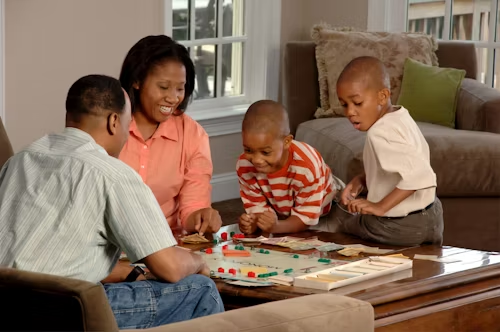Step 1: Prioritize Family Devotions
There’s something powerful about opening the Bible together as a family. Family devotions invite God into the everyday rhythm of your home and remind everyone — from the youngest to the oldest — that faith is foundational.
Choose a time that works for your family’s routine, whether before dinner, after breakfast, or right before bed. It doesn’t have to be long or complicated. Read a short passage, pray together, and talk about what it means. Even young children can engage when stories are made age-appropriate. Reading something like Noah’s Ark, followed by a craft or reflection on faith, makes the Word come alive.
Families who consistently engage in spiritual practices together often report a deeper sense of peace and unity. It’s not about perfection — it’s about presence.

Step 2: Practice Open Communication
A God-centered home is one where honesty is welcomed and feelings aren’t brushed aside. Make space for everyone to be heard — whether they’re celebrating something, struggling with something, or working through questions about life and faith.
Weekly family check-ins can be a great rhythm. Create a time to reflect, pray together, and talk openly. You might be surprised how much your family grows just by making room to listen. Strong communication isn’t just good for solving conflict — it builds trust and draws everyone closer.
Step 3: Embrace a Lifestyle of Prayer
Prayer isn’t just something reserved for mealtimes and bedtime routines. It’s a way of life — a posture of the heart. Create an environment where prayer is natural, normal, and woven into everyday moments.
Pray in the car before school drop-off. Pause to pray when someone is having a hard day. Ask your kids how you can pray for them. And don’t forget to share the ways you’ve seen God answer — it builds faith to look back and remember.
Over time, prayer becomes more than a discipline. It becomes a source of peace, connection, and daily strength.

Step 4: Create a Family Mission Statement
Your family has a unique calling, and a mission statement can help you articulate it.
Sit down together and talk about your shared values. What matters most to you? What kind of home do you want to build? What kind of legacy do you want to leave? Use words like faith, love, service, kindness, or generosity.
Once you’ve crafted your mission, write it out and display it somewhere visible — the kitchen, the hallway, the family room. Let it serve as a daily reminder of who you are and what you stand for.
Step 5: Serve Together
Serving as a family strengthens more than just your community — it strengthens your hearts.
Find ways to serve together regularly. That might mean helping at a food pantry, participating in church events, preparing meals for a neighbor, or volunteering with a local outreach. These shared experiences create lasting memories and deepen your family’s sense of purpose.
More importantly, they show your children that faith isn’t just about words — it’s about how we show up in love.

Step 6: Foster a Spirit of Gratitude
Gratitude changes the atmosphere of a home. It softens hearts, shifts perspectives, and invites joy.
Start small: go around the dinner table and have each person name one thing they’re thankful for. Keep a gratitude jar in the kitchen. Write notes to each other just to say thank you. Gratitude doesn’t ignore what’s hard — but it reminds us of what’s still good.
Over time, your family will begin to recognize God’s hand in everyday moments. And that habit of thankfulness will shape how you weather life’s ups and downs.
Step 7: Be Intentional About Quality Time
In busy seasons, it’s easy to let days pass without truly connecting. But relationships grow when we make space for each other.
Carve out regular time to be together — even if it’s simple. Game nights, movie nights, weekend walks, baking cookies, reading aloud. These aren’t just activities — they’re moments of bonding and belonging.
And as you do, don’t be afraid to bring God into those moments. Talk about your faith. Watch something that inspires hope. Ask your kids what they’re learning about God. Let those conversations grow naturally in the context of togetherness.
Final Thoughts
Creating a God-centered family culture doesn’t happen overnight — and it doesn’t require perfection. What it does require is consistency, grace, and a heart that keeps turning back to Him.
Every prayer whispered, every devotion read, every note of gratitude shared — it all adds up. Over time, those small, faithful choices begin to form something beautiful: a home where God is known, loved, and honored.
So take the next step — whatever that looks like for your family. Trust that God will meet you in it, and that He’s already at work creating something sacred right where you are.


